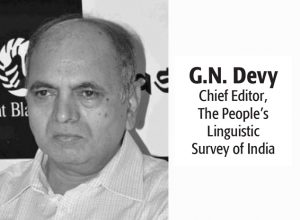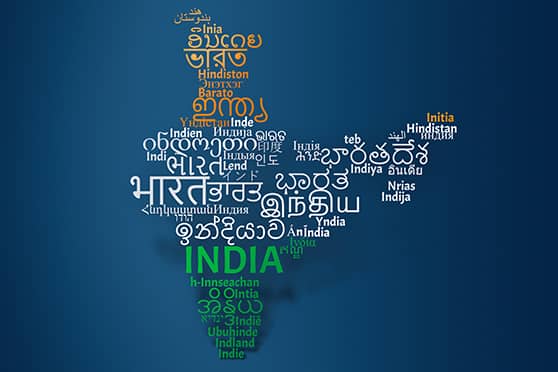
The attempt to stoke Hindi pride could have more to do with the state of the Hindi belt and the 2024 general election
Some 2,000 years ago, Tholkappiyar, the fabled author of Tolkappiyam, said that poetic words can be distributed in four types: Iyarcol, Thirisol, Thisaiccol and Vadasol. Of these, he held, ‘Vadasol’, words from northern languages, “become fit to be used in Tamil only when they adopt Tamil phonetics discarding their northern phonetics”.
From ancient times, a sensitivity to language difference has almost been the core of Dravidic self-hood. A similar sensitivity existed among the speakers of Prakrits in ancient times. It was in one of the Prakrits that Mahavir had presented his teachings in the sixth century BCE. Eighteen centuries later, Acharya Hemachandra, a major Jain scholar, poet, mathematician and philosopher, produced his Desinamamala, a treatise on the importance of Prakrit words used in Gujarat of his times as against those from Sanskrit. In the process, he gave a tangible form to the Gujarati language. Mahatma Gandhi, who defined the idea of selfhood for India in Hind Swaraj (1909), chose to write this iconic book in Gujarati. So, language sensitivity has been a feature of selfhood in the case of every Indian language.
Clarity in the Constitution
It would be unreasonable to expect a contemporary Indian to know about a 2,000-year-old Tolkappiyam or a nine-century-old Desinamamala. But would it be too much to expect the person to know about the Constitution adopted by the republic seven decades ago? The Constitution states two things with utmost clarity. One, India, is ‘a union of states’; and two, the official language used for communication between the States shall be the language that has been in use at the time of adoption of the Constitution. The move from English to Hindi can take place only if, as the language related Articles unambiguously state, ‘two or more states agree’ for the shift. Article 344 (4) provides for a ‘Committee consisting of thirty members’, ‘twenty’ from the Parliament and ‘ten’ from State assemblies, for safeguarding language related provisions.
The functions and the scope of the committee, as laid down by the Constitution, are further clarified by the practice of distribution of language as a subject between two Ministries, the Human Resource Development (HRD) Ministry and the Home Ministry. The scope of the HRD Ministry with reference to language extends to education and the promotion of cultural expression. The Home Ministry’s scope extends to safeguarding relations of the States with the ‘union’, protecting the linguistic rights of language minorities and the promotion of Hindi. The last of these, the Constitution states, has to be ‘without interference with other languages’.
Data on language decline
There are two crucial questions for the Home Ministry and its Hindi Language Committee which should be understood correctly in light of the provisions of the Constitution: ‘Has Hindi seen any growth during the last seven decades? And, if there is such a growth, does it interfere with the growth of other Scheduled languages?”
There is quite a story to tell using the data from the Census. In 2011, Hindi speakers accounted for 43.63 per cent of the total population, with a total of 52.83 crore speakers. In 1971, the number was 20.27 crore, accounting for 36.99 per cent of the total population. Between 2001 and 2011, the growth in proportion of the population was 2.6 per cent. The next most spoken language, Bangla, — the first is Hindi — had negative growth. It was spoken by 8.30 per cent of Indians in 1991, 8.11 per cent in 2001 and by 8.03 per cent in 2011. Telugu, which slid from 7.87 per cent in 1991, to 7.19 per cent in 2001 and 6.70 per cent in 2011, has a similar story to tell.
It is no different for Marathi either: 7.45 per cent (1991), 6.99 per cent (2001) and 6.86 per cent (2011). Tamil, the oldest surviving language in the country, should have received at least some attention from the Home Ministry. But the truth is that it is no different from that of Bangla, Telugu and Marathi. Tamil recorded 6.32 per cent of the total population in 1991, 5.91 per cent in 2001 and 5.70 per cent in 2011. The only major language to show decadal growth (though small) was Gujarati. And the only small yet scheduled language to show good growth was Sanskrit. The 2021 Census, when conducted, will have another count of languages in the country. And for reasons that are too obvious, the situation of all languages in the Eighth Schedule — except Hindi and Sanskrit, and perhaps Gujarati — will have worsened. In this context, the Parliamentary Committee for the promotion of Hindi should have expressed its concern about the decline of Indian languages, except Hindi, and the lack of growth of Sanskrit, which has ceased to be a living language since the ninth century.
Hindi’s growth is more fiction
If all other languages show a relative decline, why is Hindi recording steady growth? The 52.83 crore speakers of Hindi (as recorded in 2011) included not just the speaker of ‘Hindi’ but also those of more than 50 other languages. Bhojpuri, which was claimed by more than five crore speakers, and evident in its growing visibility in its cinema, literature, newspapers, songs, theatre and publication industry, is placed within Hindi. Most languages of Himachal Pradesh, Uttarakhand, Chhattisgarh, Rajasthan and Jharkhand have also been pushed into the Hindi package. Even the Pawari language (spoken mainly in Maharashtra and in some parts of Madhya Pradesh) has been shown as ‘Hindi’, overlooking the fact that most Pawari speakers may find Hindi almost unintelligible.
Thus, the story of Hindi’s growth is quite fictitious. Had the Census not included these other languages under Hindi, the strength of Hindi speakers would have gone down to about 39 crore, — just a little under 32 per cent of the total population in 2011 — and would have looked not too different from those of other scheduled languages. The Committee should also have concerned itself with making the Census data for Hindi more realistic.
The data for English speakers is far more truthful. Census 2011 reports a total of 3,88,793 Indians as English speakers (2,59,678 men and 1,29,115 women). Compare this with the least spoken among the scheduled languages, i.e., Manipuri at 17.61 lakh speakers and Bodo at 14.82 lakh speakers. No further comment is necessary; there is nothing to be proud about these figures.
Other languages shine
Hindi is a beautiful language, as is the case with any small or big language in the world. Hindi cinema has brought India some fame and some foreign currency. Hindi literature is rich and evokes pride when mentioned. Yet, it is also true that among the languages included in the Eighth Schedule, it falls within the younger lot of languages.
On the other hand, Tamil, Kannada, Kashmiri, Marathi, Oriya, Sindhi, Nepali and Assamiya have a much longer/older history. As a language of knowledge too, Tamil, Kannada, Bangla and Marathi (with their abundance of encyclopaedias and historical literature), quite easily outshine Hindi. A language evolves slowly and cannot be forced to grow by issuing ordinances.
More politics, the economy
If all wisdom related to the history of Hindi, India’s multilingualism, the federal structure of India and the issue of language sensitivity in so many States should have guided the Committee and the Official Language Committee to accept linguistic realism, what is it that prompted Home Minister Amit Shah to call for a Hindi-India all of a sudden? It is perhaps not so much the ideology of the RashtriyaSwayamsevakSangh of hyphenating Hindi-Hindu nationalism that has prompted the Home Minister’s Hindi assertion. It may also not be the BharatiyaJanata Party’s idea of majoritarian democracy that has prompted it. Hindi speakers in the country, despite the inflated figure of 52 crore against 121 crore put out by the 2011 Census, do not form a linguistic majority.
The fact remains that 69 crore (even in the 2011 Census), were non-Hindi speakers. In that sense, it was not and cannot be the majority language of India. It is quite likely that Mr. Shah’s attempt to stoke Hindi pride is required as a balm for the vast unemployment that hurts the youth in the Hindi belt, an area so crucial for the 2024 LokSabha election. Yet, the Home Minister has overlooked the fact that while harping on Pakistan being a threat to security works for Hindu mobilisation, depicting English as an anti-national entity will no longer work to mobilise the Hindi-speaking people. It makes for utterly poor economics and an absurd linguistics. Most of all, it makes for anti-federal politics. Does India need these?
Source:‘The Hindu’


